Servicing you own transmission can be a real task, especially if you do not a have a lift to get your car off the ground. trust me I know from experience that crawling under your car to service the transmission can be a headache. With that being said, if you would like to attempt servicing your own transmission, then you have come to the right place. We will give you the informational tools you need to complete the task, with as little pain as possible, and helping you save a little money at the shop.
There is a big difference in doing a drain and fill and flushing the system. Here is a great article that will explain the difference between a simple drain and fill transmission service and a full transmission flush.
Nothing prolongs vehicle life more than regular fluid changes. In automatic transmissions/transaxles, the recommended interval is about every 30,000 miles or 30 months. (Check your owner's manual or Repair Manual for your car's specifics.) The automatic transmission fluid (ATF) should be changed sooner if its dipstick reveals dark or burnt-smelling fluid. Make sure you read this article on when to flush and when not to flush your transmission fluid. Sometime a full flush can do more harm than good. Being aware of your transmissions inner workings cans ave you alot of headaches, not to mention money.
Trans-Fusion
Even those of us who change our own oil often cringe at the prospect of draining ATF. Because many transmission pans don't have drain plugs, changing the fluid can be a messy proposition—the entire pan must be removed. But even on vehicles that do have drain plugs, the pan still must be removed to change the filter.
Changing ATF is one of those messy jobs that someone has to do. Doing the deed yourself will save money and possibly time. Just as Keith Richards allegedly gets his blood changed in Switzerland at regular intervals, fresh ATF can make your gearbox perform young beyond its years.
Low Transmission Fluid Symptoms:
- Transmission Slips
- Transmission Shifts Roughly
- Noisy Transmission
- No Drive Engagement in Forward or Reverse Gears
Do-it-Yourself Fluid & Filter Change - Vehicles' vital fluids normally perform two important functions: lubricating and cleaning. As the fluid circulates through the parts, it gathers the dirt and metal shavings that can accumulate over time. If you're lucky, this debris will settle on the bottom of the pan or housing and not circulate through the system. | 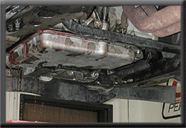 |
Automatic transmission filter kits normally contain a gasket for the pan in addition to the filter and its O-ring. You can usually pick up a filter kit at any parts store, but can really save yourself some money by ordering online. Online stores are in such competition with each other, they practically sell parts for cost. | 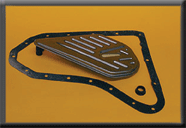 |
Fluid drains better at operating temperature. Raise and secure the vehicle, then lay down a tarp, cardboard or a newspaper under at least a 2-gallon catch pan. Next, remove the bolts from one side of the transmission pan, being cautious of hot exhaust parts and fluid. This is where it becomes tricky if you dont have a lift. be extremely careful of the hot transmission fluid if you are attempting to service the transmission on the ground | 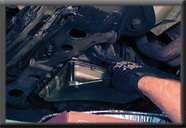 |
Gradually loosen the other bolts, which should allow the pan to tilt and begin to drain. Once all bolts are removed, lower the pan and dump the remaining fluid into the drain pan. Gently break the gasket seal with a screwdriver if necessary. Remember, the pan will still have some very hot, un-kind transmission flood in it, and will cause severe burns if you happen to spill the hot transmission fluid on yourself. Take it from experience. | 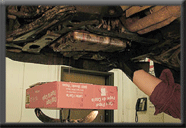 |
Clean the gasket surfaces on both the pan and the transmission housing. Inspect the pan for metal shavings or other signs of internal damage, and then clean it with solvent. It is extremely important not to leave any of the old gasket on the mounting surface as this will cause Transmission fluid leaks. |  |
Remove the old transmission filter and O-ring. The filter contains hot transmission fluid, so keep the drain pan underneath and don"t spill it on yourself | 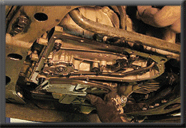 |
Install the new Transmission filter, making sure that its O-ring seats in the appropriate orifice. Also very important, make sure the Transmission filter fits snugly | 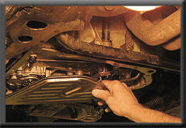 |
Attach the new gasket to the pan with oil-soluble grease -- not gasket sealer or adhesive. Be sure to carefully line up the bolt holes on the transmission pan with the bolt holes on the gasket, if it is not aligned properly, when you reinstall the transmission pan to the bottom of the transmission, you risk tearing the gasket |  |
Refer to the service manual about using thread sealer on any or all of the trans-pan bolts then screw in all fasteners finger-tight. | 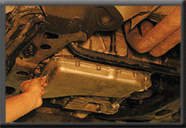 |
Torque the pan bolts to spec in a spiral pattern starting at the center. Maximum torque is often about 12 lb.-ft Always be careful to never over torque the transmission pan bolts as you risk smashing gasket and voiding the seal | 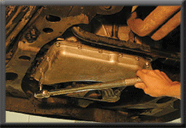 |
Lower the vehicle and fill the transmission with the recommended amount of fluid. And remember that if you ever switch to a synthetic transmission fluid, you can go back to a standard fluid | 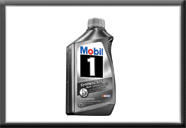 |
Start the vehicle, warm it up, then shut it off and check for leaks. If leak-free, run the vehicle up to operating temperature on level ground, move the shifter through all gears, return to Park, and check the dipstick while the engine idles. | 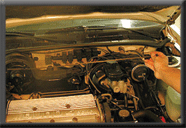 |